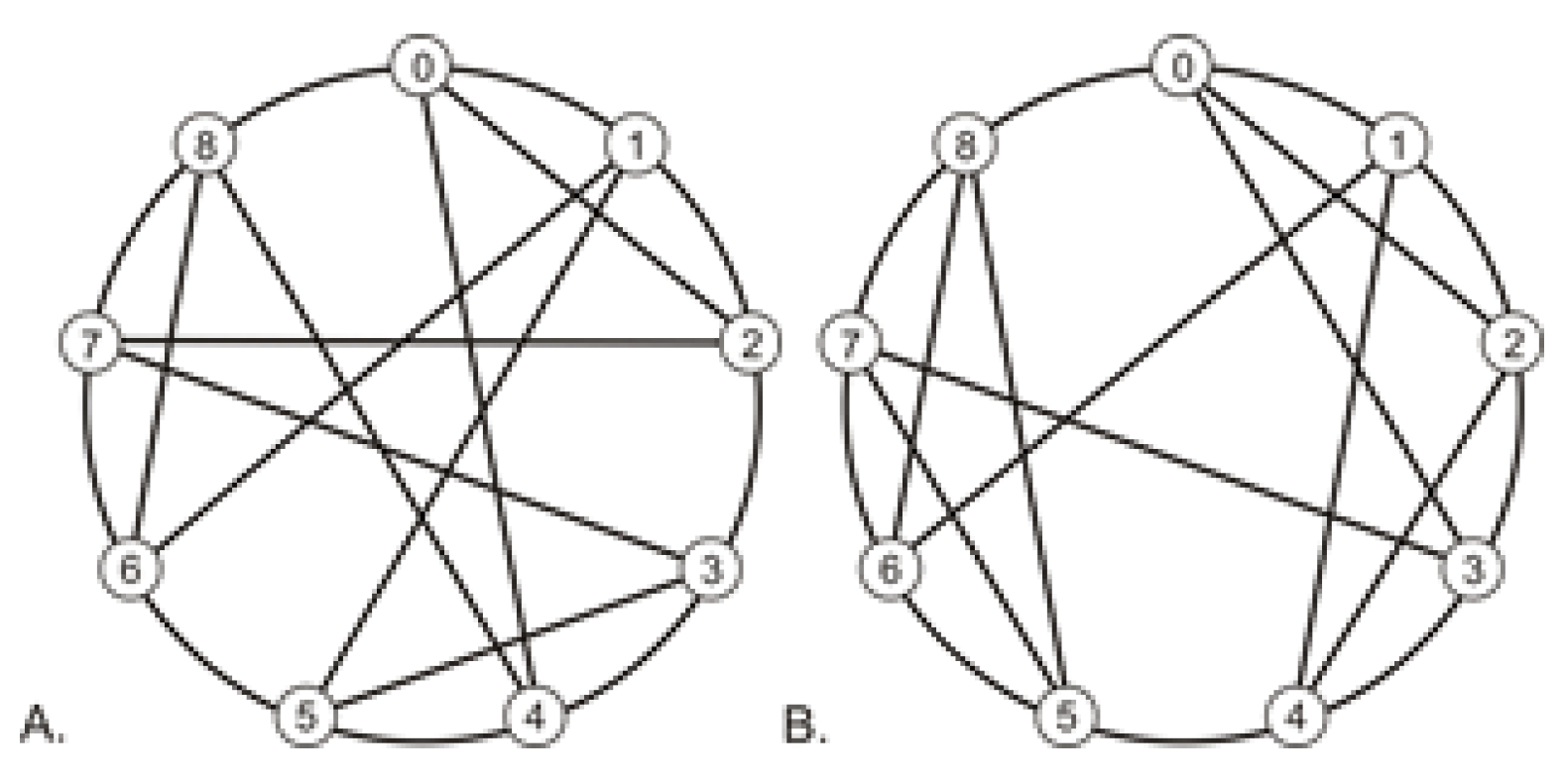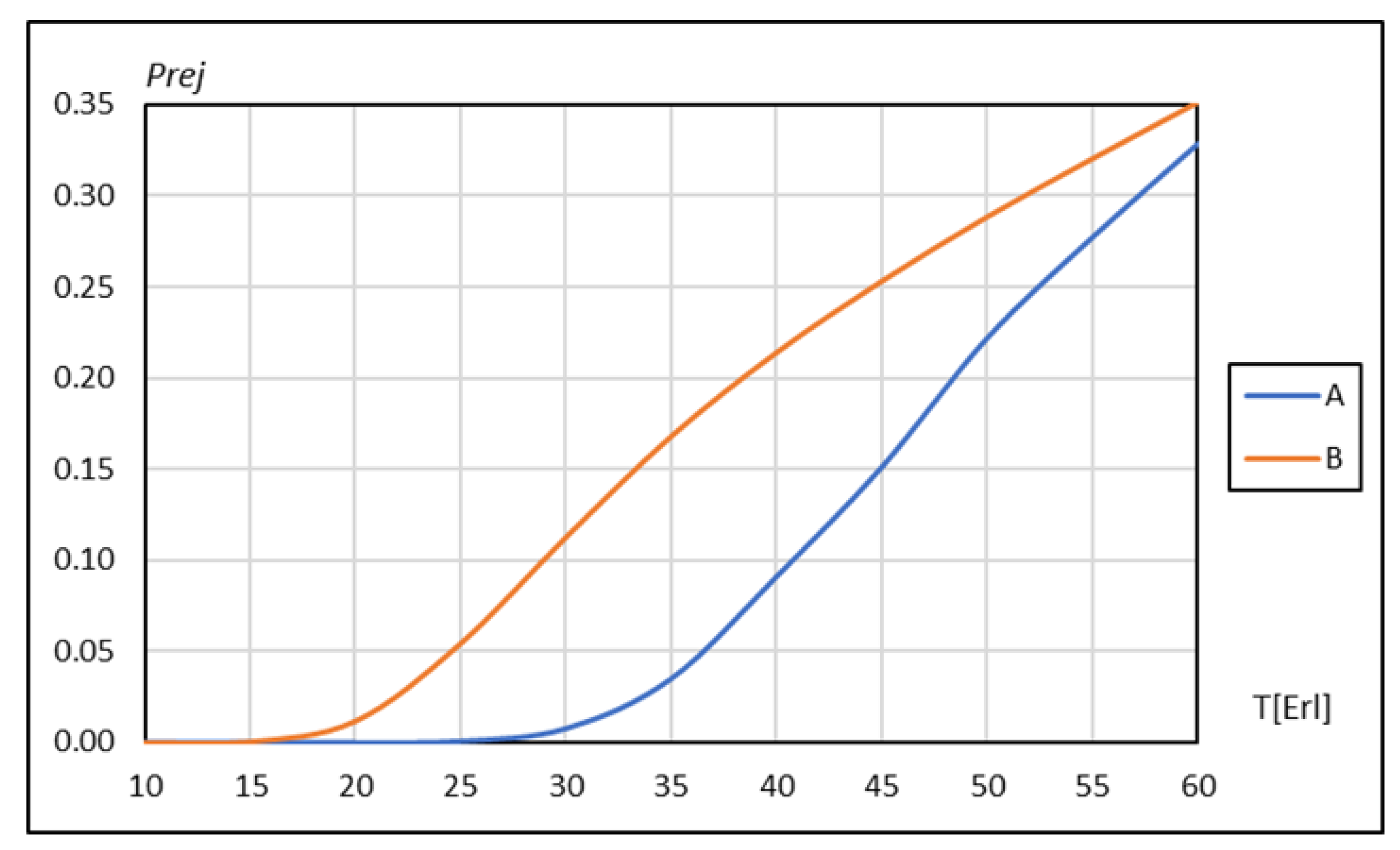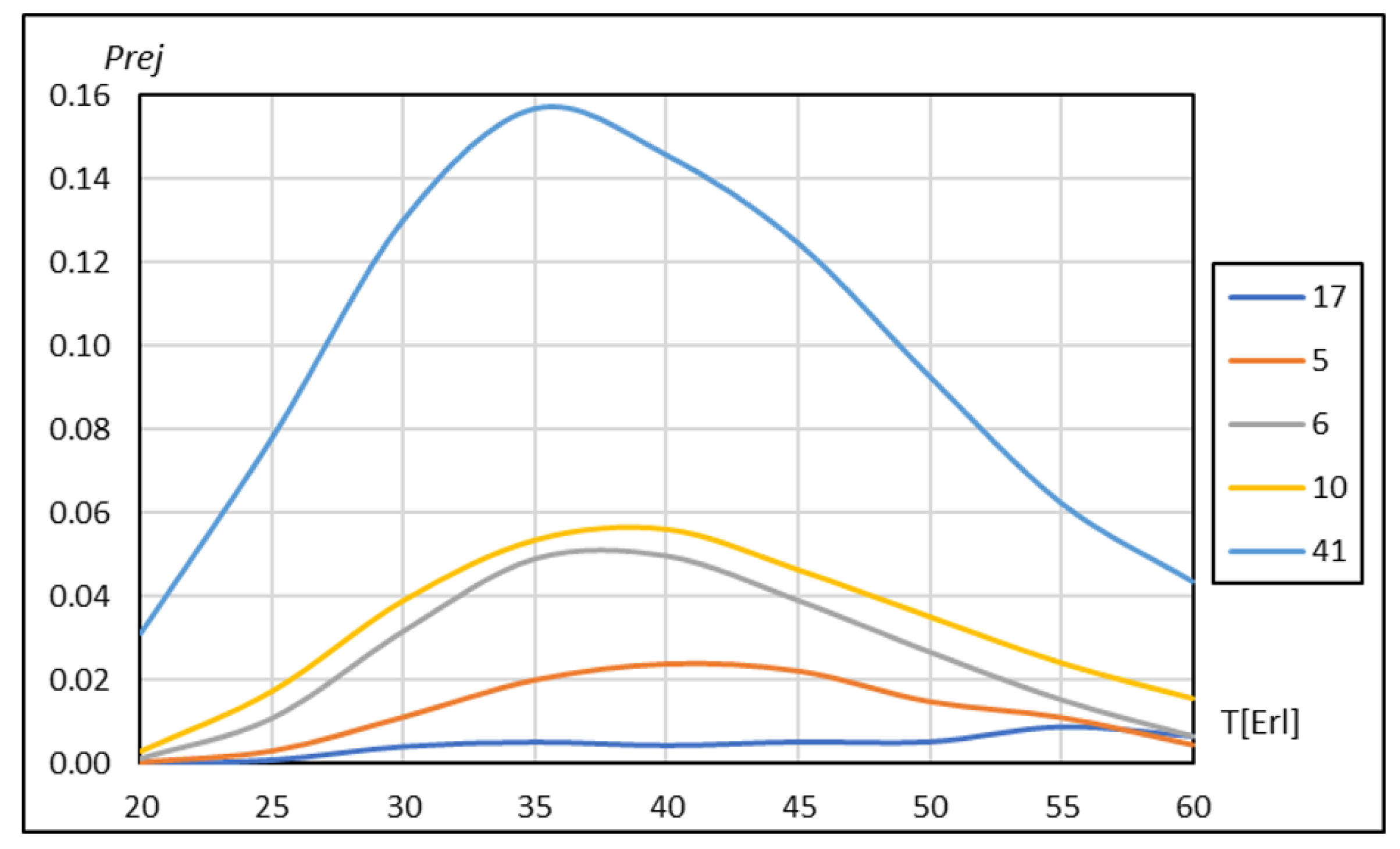2. The Adopted Method of Analyzing the Topic
In the above-mentioned publications, the method of searching such structures was described. Preliminary simulation studies of virtual ITC networks modelled with those graphs have been made. The tests consisted of determining the transmission characteristics, i.e., evaluating the probability of rejecting a service call in the function of the intensity of the traffic generated by users connected to the nodes.
The operation of the simulator consists of testing the transmission properties of the network with the time discretization. After loading the connection matrix describing the graph, all paths connecting all nodes of this graph are determined. The simulation proceeds as follows: The event queue is initiated by the selection of the first event (element) that has a time stamp. After downloading the first item with the smallest value of the timestamp from the queue, it is checked whether it is the beginning of the connection. If this condition is fulfilled, another random element is placed in the queue with its time marker being drawn according to the assumed traffic volume expressed in Erlang. The starting and the target node as well as the duration of the connection are drawn for the downloaded element. The connection setup procedure is commenced, which allocates the network resources of each of the edges forming a path from the start node to the terminal node. A transmission resource is understood as, for example, the number of slots in a route used to send user information or the bandwidth. In relation to real networks, such a situation may occur in the case of using leased lines, where for selected internode relationships, it is possible to specify for the operator, e.g., the bandwidth demand that allows for an improvement in the transmission properties of networks modelled by regular graphs [
24]. If connection matching is successful, an event with a time stamp that is the end of the connection is inserted in the queue. If there are several paths available between the starting node and the destination node, the selection of one of them is made randomly. If the element selected from the queue is an event that is the end of the connection, then the used resources are released by the given path. The simulation is conducted until the stabilization of the result at the assumed
value. For subsequent simulation results, it is confirmed whether
satisfies the inequality (
1) and the assumed number of connections.
where
is the result of the
i-th simulation,
—the average value of test results after
n simulations.
Before starting the simulation, the following files are loaded: a file showing connections between the graph’s vertices, a file to which the numbers of edges connecting the vertices of the graph will be saved, and a file containing the distribution of individual edges in alternative paths of minimum length and the results of coefficient calculations of the unevenness of the use of individual edge graphs, which will be explained later in the article. In order to carry out the test, it is necessary to determine the resources allocated to each of graph edge, the number of users generating traffic in each of the nodes, the variability range of the generated traffic (min/max (ERL)), and the difference between subsequent intensity values. The type of simulation is selected—with/without resource control (which will be explained in the section on the use of the unevenness coefficients). After the test, the number of the requests handled and unhandled and the value of the determined probability in the function of changes of the intensity of generated traffic appear on the screen. Analyzing the results obtained through the use of the simulator found that in some cases, basic parameters do not explain transmission characteristics. That is, despite the same basic parameters, i.e., the same number of nodes, diameters, and average lengths of Reference Graphs, their transmission characteristics are different. Examples of nine-node graphs, with a diameter of 2 and an average path length of 1.5, are shown in
Figure 1.
Results obtained inspired analyses carried out in order to explain the cause of the differences shown in the chart presented below (
Figure 2).
3. The Method of Proceeding
To illustrate the process of identifying the cause of the above-mentioned differences, the graphs shown in
Figure 2 were utilized.
For both graphs, the number of uses of individual edges in minimum length paths were specified. To this purpose, the exponentiation of the adjacency matrices describing the above-mentioned graphs was used. Graphs A and B are described with adjacency matrices:
Both matrices were turned into matrices
and
using the short names of the edges:
By squaring them, all paths consisting of two edges were determined [
25]. In this case, the diameter of both graphs is equal to two. In
Table 1, the obtained results of calculations are shown (this table does not include the composition of the paths connecting the nodes with themselves).
Based on the results presented in the tables, the distributions of the occurrence of individual graph edges in the minimum paths of length 1 and 2 were determined (
Table 2). In the case where the diameter of graph is large, the described operations will be repeated until all cells have been filled.
Table 3 shows the distribution of the use of graph edges. The row ∑ specifies the total numbers of uses of edges in minimum paths.
Column
contains the number of individual edges resulting from tests (total number of simulations: 13,500,000). It was concluded that the results given in
Table 2 are correlated with the results of the simulation, which is shown in
Table 3. However, for edges c, e, h, i, j, and l of graph B, although possessing identical sums, the frequencies of their occurrence in the paths obtained from the performed tests are different. This indicates that adopting this parameter as the reason for the occurrence of differences in transmission properties of the networks described by the graphs would be a mistake. Therefore, it was determined that there had to be another factor causing the lack of evenness in the distribution of the uses of edges in paths. In an attempt to identify this factor, it was assumed that the differences depend on the number of uses of edges in parallel paths. The parallel paths have the same length and consist of different configurations of edges connecting the same graph nodes. It is important to note that individual edges can be a part of multiple paths, even those that connect the same nodes. By deleting the elements referring to the connection of a node to themselves and by deleting the elements referring to the paths connecting individual nodes with a source node of single edge length, the sets of edges creating the shortest paths were obtained. The total numbers of uses of specific graph edges in all minimum length paths were calculated, as shown in
Table 4.
The authors propose the introduction of a new factor, named the inequality coefficient
and described by the following formula:
where
is the diameter of the graph and
values are calculated by Formula (
3):
where
stands for the number of uses of edges in parallel paths of length
k.
Table 5 shows calculated values of the
coefficients for individual edges of the analyzed graph B.
Calculating the sum of the value of edge use during the simulations performed, dividing it by the sum of the calculated coefficients, and then multiplying the result obtained by the coefficient determined for the given edge, it was possible to obtain results that correlate with the edge distribution determined during the simulation:
where
is a calculated number of uses of a particular edge, values
are the number of performed simulations, and
N is the total number of edges. In this example,
13,500,000.
For graph B, calculated values
compared to results obtained from simulations
are shown in
Table 6.
Conclusion: The value of the parameter determines the number of occurrences of a given edge in the minimum length paths.
Examples of amounts of the subsets of fourth-degree graphs with nine nodes are given in
Table 7. Using the prepared program, 16 different types of RG graphs out of a total 209 RG graphs were determined.
“RG Number” means a graph number assigned by the simulator. On the basis of the results in
Table 7, it was concluded that all RG graphs with the same number and the same degree of nodes have an identical sum of all
coefficients.
In order to find the reason for this rule, an analysis of the distribution of all minimum length paths specified for each node of the graphs was carried out.
The maximum numbers of nodes that can appear in the layers create a strictly specified number sequences depending on the degree and the number of nodes and act as the function of numbers of subsequent layers. The total number of minimum length paths in optimal RGs connecting a selected source node with other nodes is described by the following formula:
where the diameter of the graph
is calculated from the following formula:
where
is the number of nodes of the optimal RG.
For a perfect graph,
is the number of nodes of the perfect graph, and the diameter is determined from the following formula:
The legitimacy of this formula can be explained as follows: each
N node is connected to all other nodes through paths of a specified length; the sum of all lengths of these paths, divided by the number of nodes, gives the value
. In the discussed example, the analyzed RG graphs (
Figure 2) are not optimal structures.
The diameter of each of the structures D(G)4 = 2; average path length = 1.5.
The first layer, as well as the second one, consists of four nodes; thus, edges.
RGs have the same parameter values calculated from any node, so the global number of edges forming the minimum paths is .
Conclusion: In Reference Graphs with an identical number and degree of nodes, the total length of all minimum length paths
is equal to the total value of all
coefficients. Using the obtained results shown in
Table 7, the authors calculated and analyzed the standard deviation
of the studied coefficients from the average value
. The deviation is calculated according the following formula:
the average value of
is equal to
is the number of edges included in a given graph:
N—number of nodes;
—degree of the nodes.
The results obtained are shown in
Table 8.
Figure 3 shows the results of the performed simulations for the chosen types of graphs placed in
Table 8.
In order to better visualize the differences between the analyzed graphs, in
Figure 4, the results of tests in relation to graph 122 (its value
is equal to 0) are shown.
As has been shown, the values of decide the transmission properties of the network described with the help of graphs. Their correction, i.e., a change in the use of global transmission resources, should allow any chosen RG graph created by a specified number of nodes to possess the features of the reference graph (“best graph”). The “best graph” is such a graph whose unevenness coefficients for each edge have identical values so that the average standard deviation from the average value is zero.
The correction procedure is illustrated using the example of graph 41 with the largest coefficient value.
The following data are known: the theoretically determined mean value of the
, the sum of all coefficients
and their distribution (
Table 9), and the global transmission resources
= 18 edges× 32 units = 576.
From the determined values of coefficient. the value
(
Table 10) is subtracted.
The obtained values are divided by the sum of
and then multiplied by the originally assumed number of resource units for each edge (
Table 11).
Then, after rounding to integer values, the obtained values are added to the primary resources (
Table 12).
The obtained results of tests are shown in
Figure 6A before the correction and in
Figure 6B after the correction.
Table 7 shows that the graphs marked 27 and 28; although they have different distributions of unevenness coefficients (
Table 13), they have the same calculated value of the standard deviation, and it amounts to
.
The tests performed showed that they have the same transmission properties as those shown in
Figure 7.
Conclusion: Based on the analysis of the determined values of
, it is possible to compare the transmission properties of networks described by graphs without performing simulation tests. The smaller the value of
, the better the transmission properties of the network described by the RG graph. However, it is not a measure of these properties but merely an indicator. The analysis of the results showed that for the selected number of nodes constituting Reference Graphs of a given degree, the total number of coefficients of unevenness is strictly defined. Its exemplary values are given in
Table 14 and
Table 15.
Analyzing the determined summary values
contained in the tables, it was found that they can be calculated theoretically for any Reference Graph using the following formula:
where
N is the number of nodes forming the graph and
is average path length in the graph. The legitimacy of this formula can be explained as follows: each
N node is connected to all other nodes through paths of a specified length; the sum of all lengths of these paths divided by the number of nodes gives the value
.













